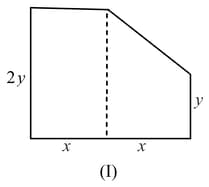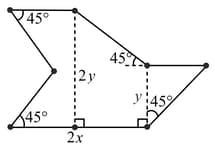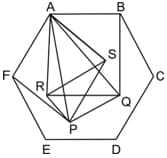MEDIUM
Earn 100
The lengths of the medians through acute angles of a right angled triangle are 3 and 4. Its area is -
50% studentsanswered this correctly
Important Questions on Similarity, Right Triangles, and Trigonometry
HARD
Mathematics>Geometry - III>Similarity, Right Triangles, and Trigonometry>Derive the formula A = 1/2 ab sin(C) for the area of a triangle by drawing an auxiliary line from a vertex perpendicular to the opposite side
In the figure given below, if the areas of the two regions are equal then which of the following is true?


HARD
Mathematics>Geometry - III>Similarity, Right Triangles, and Trigonometry>Derive the formula A = 1/2 ab sin(C) for the area of a triangle by drawing an auxiliary line from a vertex perpendicular to the opposite side
Suppose we have two circles of radius each in the plane such that the distance between their centres is . The area of the region common to both circles lies between
MEDIUM
Mathematics>Geometry - III>Similarity, Right Triangles, and Trigonometry>Derive the formula A = 1/2 ab sin(C) for the area of a triangle by drawing an auxiliary line from a vertex perpendicular to the opposite side
Consider four triangles having sides and . Among these the triangle having maximum area has sidesHARD
Mathematics>Geometry - III>Similarity, Right Triangles, and Trigonometry>Derive the formula A = 1/2 ab sin(C) for the area of a triangle by drawing an auxiliary line from a vertex perpendicular to the opposite side
In the figure given below, is a regular hexagon of side length unit, and are squares. Then the ratio equals

MEDIUM
Mathematics>Geometry - III>Similarity, Right Triangles, and Trigonometry>Derive the formula A = 1/2 ab sin(C) for the area of a triangle by drawing an auxiliary line from a vertex perpendicular to the opposite side
Let be respectively the areas of a regular pentagon, regular hexagon and regular heptagon which are inscribed in a circle of radius . ThenMEDIUM
Mathematics>Geometry - III>Similarity, Right Triangles, and Trigonometry>Derive the formula A = 1/2 ab sin(C) for the area of a triangle by drawing an auxiliary line from a vertex perpendicular to the opposite side
A triangle has area of square units and circumference units. If and are respectively the length of the altitudes of the triangle drawn from the vertices and then HARD
Mathematics>Geometry - III>Similarity, Right Triangles, and Trigonometry>Derive the formula A = 1/2 ab sin(C) for the area of a triangle by drawing an auxiliary line from a vertex perpendicular to the opposite side
In a rectangle points and are the mid-points of and respectively. Lines and when extended intersect at and lines and when extended intersect at . If the area of rectangle is square units, then the area of (in square units) isHARD
Mathematics>Geometry - III>Similarity, Right Triangles, and Trigonometry>Derive the formula A = 1/2 ab sin(C) for the area of a triangle by drawing an auxiliary line from a vertex perpendicular to the opposite side
Let be a square and let be point on segment such that . Let be a point on segment such that . Then the ratio of the area of quadrilateral to the area of the square isHARD
Mathematics>Geometry - III>Similarity, Right Triangles, and Trigonometry>Derive the formula A = 1/2 ab sin(C) for the area of a triangle by drawing an auxiliary line from a vertex perpendicular to the opposite side
Let be a triangle such that and . Choose points on respectively, such that . Then isHARD
Mathematics>Geometry - III>Similarity, Right Triangles, and Trigonometry>Derive the formula A = 1/2 ab sin(C) for the area of a triangle by drawing an auxiliary line from a vertex perpendicular to the opposite side
Denote Area and by area of the triangle , perimeter of the triangle and length of the line segment respectively.Let be a convex quadrangle and the diagonals and intersect at . Then
MEDIUM
Mathematics>Geometry - III>Similarity, Right Triangles, and Trigonometry>Derive the formula A = 1/2 ab sin(C) for the area of a triangle by drawing an auxiliary line from a vertex perpendicular to the opposite side
In a if and then the area of the triangle isMEDIUM
Mathematics>Geometry - III>Similarity, Right Triangles, and Trigonometry>Derive the formula A = 1/2 ab sin(C) for the area of a triangle by drawing an auxiliary line from a vertex perpendicular to the opposite side
In a , points and are on and , respectively, such that is parallel to . Which of the two following equalities always hold? (Here, denotes the area of ).
.
.
MEDIUM
Mathematics>Geometry - III>Similarity, Right Triangles, and Trigonometry>Derive the formula A = 1/2 ab sin(C) for the area of a triangle by drawing an auxiliary line from a vertex perpendicular to the opposite side
If are the sides of a and exradii are respectively then HARD
Mathematics>Geometry - III>Similarity, Right Triangles, and Trigonometry>Derive the formula A = 1/2 ab sin(C) for the area of a triangle by drawing an auxiliary line from a vertex perpendicular to the opposite side
In a triangle if then all the possible values of lies inEASY
Mathematics>Geometry - III>Similarity, Right Triangles, and Trigonometry>Derive the formula A = 1/2 ab sin(C) for the area of a triangle by drawing an auxiliary line from a vertex perpendicular to the opposite side
If the sides of triangle are and Then the area (in sq cm) of triangle isHARD
Mathematics>Geometry - III>Similarity, Right Triangles, and Trigonometry>Derive the formula A = 1/2 ab sin(C) for the area of a triangle by drawing an auxiliary line from a vertex perpendicular to the opposite side
Let and be positive real numbers. Suppose and are the lengths of the sides of a triangle opposite to its angles and respectively. If , then which of the following statements is/are TRUE?